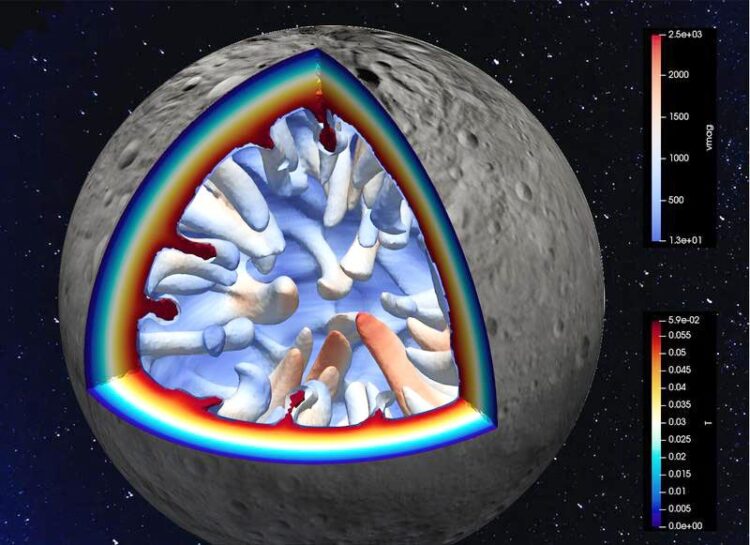Bombardment of Planets in the Early Solar System

Visualisation of convective motions that took place in the interior of Vesta in its early evolution phase.
(c) Dr Wladimir Neumann (Heidelberg)
Studies of the asteroid Vesta provide new findings on the formation of Earth-like planets
The largest asteroid in our Solar System – Vesta – was exposed to an extensive series of impacts by large rocky bodies much earlier than previously assumed. Researchers of an international collaboration, including earth scientists of Heidelberg University and Freie Universität Berlin, reached this conclusion based on analyses of Vesta meteorites, numerical simulations, and observations carried out with the space probe Dawn in 2011 and 2012. This novel finding opens up an entirely new picture of the chronology of the collision history in the early Solar System. The early bombardment affected all Earth-like planets, and thus provides important insights into the early phase of our Earth.
The Earth-like planets in the early Solar System first grew by accumulation of dust grains; in the final stage they were fed by impacts from increasingly larger rocky bodies. This is also true for the asteroid Vesta. Early in its formation, Vesta became hotter and hotter, producing a magma ocean near the surface as well as a liquid metallic core. Over time, other objects bombarded its crust, ejecting its material that was transported to the Earth as meteorites. Chemical analyses of these meteorites have shown that further cosmic impacts changed the composition of Vesta’s mantle and crust significantly, even after core formation. The mass that accumulated right after Vesta’s core formed was considerably larger than later additions, as Freie Universität Berlin geoscientist Prof. Dr Harry Becker explains.
Through computer modelling of Vesta’s thermal evolution, which were conducted by Dr Wladimir Neumann at the Institute of Earth Sciences of Heidelberg University, the time frame of the early impacts can now be narrowed down more precisely. “For the material of the impactor to mix with the mantle fairly homogeneously in the first place, the mantle has to be hot enough and undergo convective motions,” explains Dr Neumann. “Our models have shown that this was true only for impacts within the short time span between 4.56 and approximately 4.50 billion years ago.” Until now, scientists assumed that the main phase of this bombardment occurred many hundreds of millions of years later, at a time when several of the large impact craters were forming on the Moon.
Apparently, the impactors do not originate from today’s asteroid belt, as previously thought, but from the inner Solar System where the terrestrial planets formed. “For our Earth, this again emphasises the significance of an early hot phase with a magma ocean that was continually renewed through major impacts. During this time, the atmosphere was blazing hot for millions of years. Only much later could the water oceans form when the hot steam cooled and fell as rain,” explains Prof. Dr Kai Wünnemann from the Natural History Museum Berlin and Freie Universität Berlin.
The research at Heidelberg University was substantially funded by the Klaus Tschira Foundation. The contributions from Berlin were supported by the Transregional Collaborative Research Centre “Late Accretion onto Terrestrial Planets” whose participating institutions also include, among others, the University of Münster and that is funded by the German Research Foundation. Other participants in the international study include researchers from Macau University of Science and Technology (Macau), the University of Nice Sophia-Antipolis (France), the University of California at Davis and the University of California San Diego (both USA), the University of Bayreuth, the Planetary Science Institute in Tucson (USA), and the Institute of Planetary Research of the German Aerospace Center. The results of the study were published in the journal “Nature Astronomy”.
Caption:
Visualisation of convective motions that took place in the interior of Vesta in its early evolution phase. In the outer hull, the material is rigid and immobile due to a low temperature. The dimensionless temperature increases with depth. The interior visualises ascending currents of warmer and less dense material and descending currents of colder and denser materials.
Contact:
Heidelberg University
Communications and Marketing
Press Office, phone 49 6221 54-2311
presse@rektorat.uni-heidelberg.de
Wissenschaftliche Ansprechpartner:
Dr Wladimir Neumann
Heidelberg University
Institute of Geosciences
wladimier.neumann@geow.uni-heidelberg.de
Prof. Dr Kai Wünnemann
Natural History Museum Berlin
Freie Universität Berlin
Phone +49 30 2093 8857
Kai.wuennemann@mfn.berlin
Prof. Dr Harry Becker
Freie Universität Berlin
Institute of Geological Sciences
Phone +49 30 838 70668
hbecker@zedat.fu-berlin.de
Originalpublikation:
M.-H. Zhu, A. Morbidelli, W. Neumann, Q.-Z. Yin, J.M.D. Day, D.C. Rubie, G.J. Archer, N. Artemieva, H. Becker, K. Wünnemann: Common feedstocks of late accretion for the terrestrial planets. Nature Astronomy (30 September 2021), https://doi.org/10.1038/s41550-021-01475-0
Weitere Informationen:
Media Contact
All latest news from the category: Earth Sciences
Earth Sciences (also referred to as Geosciences), which deals with basic issues surrounding our planet, plays a vital role in the area of energy and raw materials supply.
Earth Sciences comprises subjects such as geology, geography, geological informatics, paleontology, mineralogy, petrography, crystallography, geophysics, geodesy, glaciology, cartography, photogrammetry, meteorology and seismology, early-warning systems, earthquake research and polar research.
Newest articles

Innovative 3D printed scaffolds offer new hope for bone healing
Researchers at the Institute for Bioengineering of Catalonia have developed novel 3D printed PLA-CaP scaffolds that promote blood vessel formation, ensuring better healing and regeneration of bone tissue. Bone is…

The surprising role of gut infection in Alzheimer’s disease
ASU- and Banner Alzheimer’s Institute-led study implicates link between a common virus and the disease, which travels from the gut to the brain and may be a target for antiviral…

Molecular gardening: New enzymes discovered for protein modification pruning
How deubiquitinases USP53 and USP54 cleave long polyubiquitin chains and how the former is linked to liver disease in children. Deubiquitinases (DUBs) are enzymes used by cells to trim protein…



